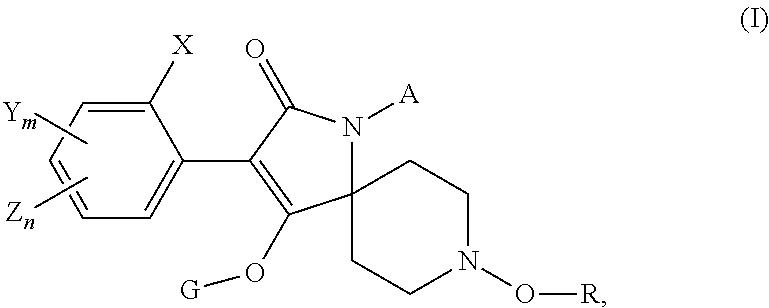Use of tetramic acid derivatives as nematicides
a technology of tetramic acid and derivatives, applied in the field of tetramic acid derivatives as nematicides, can solve the problems of limited or restricted use, stunted growth, swelling or gall formation, damage to plant and crop yields, etc., and achieve the effect of reducing the population density of nematodes
- Summary
- Abstract
- Description
- Claims
- Application Information
AI Technical Summary
Benefits of technology
Problems solved by technology
Method used
Image
Examples
example 1
Solo Use of the Compound According to Formula (I)
[0258]POT TRIALS: Foliar spray in Cotton against nematodes Meloidogyne incognita (RKNi) using
Trial Design and Layout:
[0259]12 1-L Clay pots were used per treatment. Cotton: Fibre Max 966 seeds were planted into pots and allowed to germinate and grow into young plants. The pots were artificially infested with nematodes (RKNi) 2 days after treatment.
[0260]APPLICATION: Compounds A and B and comparison Spirotetramat were sprayed as a normal foliar spray with hollow cone nozzles directed onto the plants. The compounds A, B and spirotetramat used were formulated as a suspension concentrate formulation at a dose rate of 100 g / ha. The compounds were diluted to a spray volume of approx 1501 / ha, which was used on the young plants. The treatment was applied when the plants had at least 2 true leaves.
[0261]Industry comparison Abamectin as a seed treatment was also included in the trials as a comparison. AVICTA® 500 FS from Syngenta AG was used at...
example 2
Synergistic Use of a First Composition Comprising a Nematicide with a Second Composition Comprising Compound A According to Formula (I′)
[0266]POT TRIALS: Seed treatments and Foliar spray in sugar beets (Beta Vulgaris cv Impulse) against root nematodes Heterodera schachtii Schmidt (SBCN) (origin Münster, Germany)
Trial Design and Layout:
[0267]15 7-L pots were used per treatment containing 7-L soil with an organic matter content of 2% (drench soil+sand). Seeds were planted into pot soil 1 cm deep and allowed to germinate and grow into young plants in a polytunnel. During the winter months, the pots were placed in a greenhouse. The pots were artificially infested with nematodes (SBCN) when preparing the soil for each pot and just before planting.
[0268]APPLICATION: Compounds A and comparison Spirotetramat were sprayed as a normal foliar spray with hollow cone nozzles directed onto the plants. The compounds A and Spirotetramat used were formulated as a suspension concentrate formulation a...
example 3
Synergistic Use of a First Composition Comprising a Nematicide with a Second Composition Comprising Compound B According to Formula (I′)
[0274]POT TRIALS: Seed treatments and Foliar spray in sugar beets (Beta Vulgaris cv Impulse) against root nematodes Heterodera schachtii Schmidt (SBCN)
Trial Design and Layout:
[0275]8×350 ml pots were used per treatment containing 350 ml soil (70% drench soil and 30% sand). 1 Seed per pot were planted into pot soil 0.5 cm deep and allowed to germinate and grow into young plants. Plants were kept under constant conditions of 25° C. during the day and 23° C. during the night with a humidity of 50-60% with 14 hour light periods. The pots were artificially infested with nematodes (SBCN) 7 days after sowing. For inoculation, 3 holes are drilled into the soil and 2 ml suspension of the nematodes per hole are applied.
[0276]APPLICATION: Compounds B and comparison Spirotetramat were sprayed as a normal foliar spray with hollow cone nozzles directed onto the p...
PUM
| Property | Measurement | Unit |
|---|---|---|
| humidity | aaaaa | aaaaa |
| swelling | aaaaa | aaaaa |
| resistance | aaaaa | aaaaa |
Abstract
Description
Claims
Application Information
 Login to View More
Login to View More - R&D Engineer
- R&D Manager
- IP Professional
- Industry Leading Data Capabilities
- Powerful AI technology
- Patent DNA Extraction
Browse by: Latest US Patents, China's latest patents, Technical Efficacy Thesaurus, Application Domain, Technology Topic, Popular Technical Reports.
© 2024 PatSnap. All rights reserved.Legal|Privacy policy|Modern Slavery Act Transparency Statement|Sitemap|About US| Contact US: help@patsnap.com










